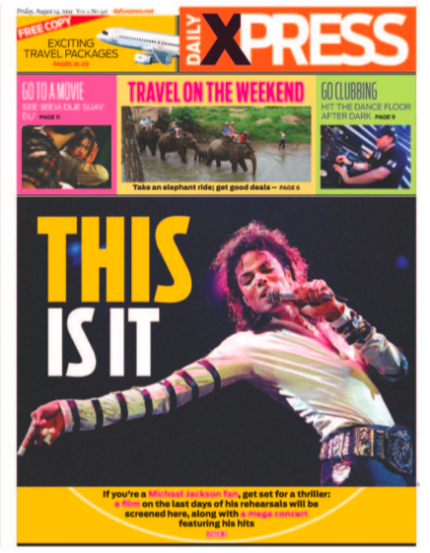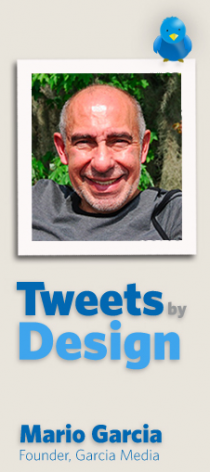TAKEAWAY: Let that blog reveal the informal, but informed, you. Tips for the new blogger, formerly known as a journalist.
ALSO: Multimedia literacy and today’s newsrooms PLUS: Pure Design download: How the eyes move on the screen
The subject was blogging

Spent most of the last two days discussing blogs and blogging with the energetic team of Gulf News, of Dubai. As the team prepares to launch a variety of multi-themed blogs—from food to politics to life in the city of the future—-we have had some informal give and takes about this new form of active journalism and how to tackle it.
For the traditional journalists in the room, I can almost feel their pain, anxiety and, of course, fear, as they say hello to Blog City.
I tried to share my own experience as I toil away trying to put something together at this venue everyday. Unfortunately, we all learn as we go in this new mode of expression.
What I have learned
It’s very personal: Your blog is about you and me, an extension of you the writer and what you think about a variety of topics. Blogs include an audience that gets back to you immediately to tell you how they feel about what you just wrote. In most cases, your readers come to you because they have an interest in you or your topic. The audience is part of the conversation. Traditional journalism is more passive, with more time for verification, editing, polishing. Those of us trained as traditional journalists have trouble assimilating this very aspect of blogging. We were trained not to go with the story until we had all the facts, and then to have an extra set of eyes look at the story, polish it before publication. With blogging, we are on our own, letting our senses and our feelings guide us, and a finger always close to the Publish Button.
The extended conversation: To me, the blog is an extension of my daily conversations. I simply try to take note of those parts of a chat that may offer a tip here or there, some guidance, some provocative statement.
The extended meditation: I do a lot of my thinking while running—-my daily meditation, if you will. For years, I basically kept those thoughts to myself. Now, I try to capture those bits of meditation which might be of interest to someone else in my audience, or that may find an answer through the expertise of one of my readers. Meditations are not all about profound topics Often, they are a part of our confusion over some issue that prevails in our mind.
The funny moment: If you write a daily blog, you are going to have days when the most memorable moment of your last 24 hours has been a funny one. Blog about it. Share it.
Let the senses guide you: I find that many of my blogs are sometimes inspired by an ephemeral moment based on something I saw, or that I heard, or that I felt. If you are aroused by a page on that magazine that the person sitting next to you at the airline lounge is reading, then get your own copy, study it, discover what enticed you, then write about it. Engage your senses. Share the experience.
Free yourself of journalistic taboos A blog is not a newspaper column, it is not an article for an academic magazine, and, it is far from a book. Think of the blog as a page in your diary, perhaps the most honest and spontaneous form of writing anyone of us has ever experienced. Turn scribbles into full sentences. If you don’t like the structure of that sentence after you post it, go back and fix it. Or, simply leave it as is. It is a good thing that blog readers are as much in a hurry as we are, and they can be quite forgiving. I know.
Before the blogs: circa 1996
I often recall a memorable little tidbit of a conversation, an incident, a presentation or project launch where something that happened would have been delicious blog material. But, alas, there was no blog at the time it happened. “How did we survive?,” I ask myself.
So, I am now writing down those pre-blog moments as they come to mind, hoping to do a series of “Life before the blog: did we have more time?” Coming your way when I have assembled enough of them.
Then there are the “unbloggables”——appetizing tidbits, incidents, conversations, gossip, real action, real news, that one simply can’t blog about. Not yet, anyway.
My final quip to the future bloggers here: Practice for about two weeks to see how blogs and you get along with each other. Do you feel the winds of blogspiration coming your way each day? Do you think you can sustain it, without abandoning life as you know it and enjoy it? If you had to give up an activity everyday to blog, what would that be? And, of course, if you are a journalist working full time for a newspaper, you know that you STILL have that job to take care of too, and you don’t wish to repeat yourself.
Overall, most of these future bloggers will enjoy the experience, the give and take, the new form of expression where the journalist in you can flex his muscies, do a daily workout and get instant reaction to an idea. Isn’t that why we got into journalism?
With blogs, journalists (and others) have found a magnificently spontaneous way to tell stories, influence opinion and challenge themselves and their craft. It is just getting started that’s a rough patch.
Look forward to reading those blogs by my Gulf News friends and colleagues.
An industry in needs of skilled, creative recruits
The entry above shows us that the need for skills and creativity has never been at a higher premium. The young people in our industry already have to pass more challenging tests before they are hired (especially in the existing economy). The traditional journalists of a certain age desperately need to re-train, to adapt new forms of storytelling, and to ply their craft in a digital world where many definitions are being rewritten, from what is news to what is relevantly popular, not to mention, what really matters to an audience oversaturated with information and visuals.
Now comes this report, via London’s The Guardian, with a headline that puts it in a nutshell:
Literacy level of recruits now a major concern for media, report finds
Training watchdog warns of ‘critical’ skills gap in writing, editing and interviewing among entrants to media
The report states that the impact of digital technology on the publishing industry has exposed “critical” skills gaps at a time when traditional skills such as good writing, editing and interviewing were “becoming even more important so that customers are prepared to pay for high quality content”.
I wonder how the same report would stand if reporting on the readiness of similar entry-level recruits in American newsrooms.
One important revelation and recommendation from this report is that it is ” vital for staff to understand and maximise the value of multimedia and multiplatform content in the UK and abroad.”
Although this appears to be such a sensible recommendation, perhaps not needed on a 2009 list of tips for publishing houses, I agree that we must continue to remind traditional journalists about the importance of multimedia and multiplatform.
As one who sits in newsrooms across the globe daily, I agree with what the UK report reveals. Until we begin to treat multimedia and multiplatform as part of the daily vocabulary of the newsroom, planning meetings and, more importantly, the creative thinking and conceptualizing of stories, not much progress will be made.
Many newsrooms have the technology, the young talent and every possible multiplatform resource, except one: the attitude and the culture of thinking in terms of multimedia. Stories are discussed and planned in terms of print, period. Not good, and an element that probably contributes to the ills described by this UK report.
For complete article:
http://www.guardian.co.uk/media/2009/aug/13/literacy-concerns-media-recruits-skillset-report
In Bangkok: Xpress prepares for Jackson farewell film

Daily Xpress is one of Thailand’s most colorful tabloids, aimed at young readers and commuters
Leroy Sylk, art director of Bangkok’s Daily Xpress, sends us a front page he designed today, to announce that the film, This is It, based on footage of Michael Jackson’s rehearsals in Los Angeles for his London farewell concerts, will be released in Bangkok the same day as it opens in the US and worldwide, October 30.
The film offers a behind the scenes look at Jackson, his career and final rehearsals for what would turned out to be his last performance.
The Daily Xpress is Thailand’s newest newspaper, distributed as both a free newspaper, and as a supplement to the broadsheet daily, The Nation.
“The showing of the Jackson film’s screening here in Bangkok will coincide with a star-studded concert featuring Thai bands performing Jackson’s hits. So it’s all going to be one mega-concert for our city.”
Pure Design download today: How the eyes move across a screen

On a broadsheet, the eye moves from top left to bottom right diagonally. Photos get the first look, then headline, then caption. For online users, eyes move left to right on the screen, and same applies to tabloid/magazine pages.

Who is Jacky?
Every Sunday: Jacky leads us to his favorite picks from Bild Am Sonntag!
Pure Design: Download entire section: Type
Download entire first section of Pure Design: Words
Now that I have fully presented the first of six sections of Pure Design on TheMarioBlog, I am offering the entire initial section, “Words,” available for download—all 33 pages of it. This may be useful for those of you saving or printing out Pure Design and will be done following each of the remaining sections. At the end of our journey through words, type, layout, color, pictures, and process, I will publish the entirety of Pure Design in one file.
WAN’s World Trends 2009 Report

The 2009 edition of World Press Trends from WAN/IFRA is now available. I always like to review this report for its complete information on global circulation, advertising and online trends in our industry. All countries in the world where daily newspapers are published are covered in the publication.
This year the WAN/IFRA folks have decided to publish a print version but only make the book available on pdf.
Those interested go:
http://www.wan-press.org/forms/wpt2009.html

Follow me at www.twitter.com/tweetsbydesign
Follow the Marios

Two Marios. Two Views.
Follow Mario Jr. and his blog about media analysis, web design and assorted topics related to the current state of our industry.
http://garciainteractive.com/
Visit Mario Sr. daily here, or through TweetsByDesign (www.twitter.com/tweetsbydesign)
In Spanish daily: The Rodrigo Fino blog
:
To read TheRodrigoFino blog, in Spanish, go:
https://garciamedia.com/latinamerica/blog/
TheMarioBlog posting #332